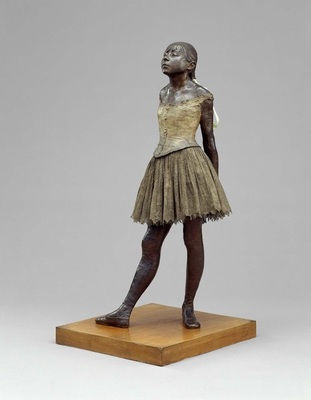
Description
NARRATOR: This is one of the most famous of Edgar Degas’ many images of ballet dancers. When the original version was exhibited in Paris in 1881, it caused a sensation.
George Shackelford, formerly chair of our Art of Europe Department, tells us why:
GEORGE SHACKELFORD: Critics were startled by the lifelike quality of the figure…by what they saw as her ugliness…It’s hard for us now to capture that sense of where this girl fit in society when Degas was making her, because we look upon her as…a little girl of great charm and resilience…even though caught up in the sculpture was the public perception of the ballet dancer as a woman of easy virtue.
PAUL MANTZ: The result is almost frightening…the wretched child stands in a cheap gauze dress, with a blue ribbon…and shoes on her feet. Terrifying because she is without a thought, she brings forward her face, or rather her little mug, with bestial impudence.
NINA DE VILLARS: But let the artist be reassured: the work that is misunderstood today will one day perhaps be in a museum looked upon with respect as the first formulation of a new art.
NARRATOR: The Little Dancer that you are looking at was cast in bronze after Degas’s death. Again, George Shackelford:
GEORGE SHACKELFORD: The original statuette, of which this is a kind of reproduction, was made of wax. The body of the dancer was actually sculpted from a kind of wax that had a vaguely translucent quality. The hair of the dancer was an actual wig made of horsehair. …The bodice of her tutu was made of silk with buttons that worked. The skirt, as the skirt here, was made of actual fabric. There was a silk ribbon in her hair, as there is a silk ribbon here. …
Some of the critics actually loved the revolutionary quality of it, whereas others found that it had transgressed…or gone too far beyond the boundaries of what was acceptable in sculpture. …They found it unsettling, and it seemed more like a doll to them than like a great bronze…by a master sculptor.
…But in the original sculpture, one is very aware of the differences in… materials, and the bronze attempts to give us those differences…by the way it’s been colored after the casting. You’ll notice that the bodice is given a kind of whitish tone, whereas the legs or the body are kept a kind of dark brown or bronze color.
Details
- Work Date:
- Original model 1878–81, cast after 1921
- Location:
- Sidney and Esther Rabb Gallery (Gallery 255)
- Dimensions:
- Total height: 103.7 cm; Height of Figure: 98 cm; Height of base:5.7 cm; width of base 45.5 cm; depth of base: 46.5 cm
- Medium:
- Bronze, gauze and satin
- Credit Line:
- Frederick Brown Fund and Contributions from William Claflin and William Emerson